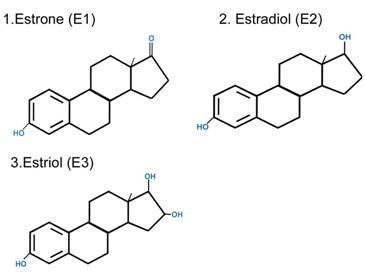
There are three common forms of the hormone we call “estrogen” (and many many lesser variations and subvarieties). Understanding what each one is and does can be helpful in deciding which one(s) to supplement with when planning HTR )hormone replacement therapy)
Estradiol is the major estrogen produced by ovaries and is the strongest (the most effect for the least quantity) form. Estradiol is the “active” estrogen–the one that is capable of the fullest range of estrogen effects because it is the one that actually goes out there in our tissues and sockets into estrogen receptors and causes estrogen effects. In addition to being made by ovaries, it can also be produced by conversion from a number of precursors in the adrenal glands. It requires certain nutrients at specific levels to be metabolized properly, and it requires certain other factors to be present to determine which metabolites (some of which are considered more desirable than others) it is broken down into.
Estrone is considered a weaker form of estrogen. It is typically produced by special belly fat cells, and is the major estrogenic form found in naturally-menopausal women who are not taking HRT. It is not directly active in tissues, but can be readily converted by most women to estradiol for actual use; because of this it is considered by biochemists to more properly be thought of as an estradiol precursor (although the conversion can go both ways, meaning that estrone can also be considered a breakdown or even a storage form of estrogen). It is sometimes considered “safer” than estradiol by virtue of its weakness, but since larger quantities are required to get the same effects as a smaller quantity of estradiol, other sources consider it no more or less safe than estradiol.
Estriol is a metabolic waste product of estradiol metabolism that can still have some effects in a limited number of estrogen receptors. It is formed in the liver and is 8% as potent as estradiol and 14% as potent as estrone. Once estriol is bound to an estrogen receptor, it blocks the stronger estradiol from acting there. Thus it is considered to have both estrogenic and antiestrogenic actions. There is also some evidence that, because it is so weak and blocks the stronger forms, estriol can be considered to have “anti-cancer” action. To take it in quantities adequate to have effects comparable to estradiol (that is, to occupy as many receptors as a needs-meeting level of estradiol), however, the risk rises to the same level with estriol as with estradiol. A particular breakdown product of estriol, 16-hydroxyestrone, is elevated in women receiving oral estriol and is associated with an increased risk of breast and cervical cancers. Estriol has also been implicated as a source of interference in lab tests for estradiol, leading to “clinically significant” testing errors. It is believed to have special efficacy for genitourinary tissues and skin generally, but that is poorly studied and results of existing research are not conclusive.
Read more: http://surmeno.blogspot.com/2006/07/three-estrogens-estradiol-estrone.html#ixzz10mG3mNTK
How to Balance Estrogen Levels with Food!
By KCout, eHow Member
Difficulty: Moderately Easy
Instructions
The meat industry may be sabotaging your weight lose efforts! ne by-product of excess estrogen is increased fat on your hips, belly, thighs and buttocks! Think about it, the meat industry use hormones to plump up animals for slaughter. Hormones do the same thing to your body that is why men don’t usually carry weight in their buttocks and hip area. So extra estrogen in your diet will add extra pounds!
Signs that you may be estrogen-dominant:
- Stubborn fat in female areas like hips and thighs
- Intense PMS
- Breast pain
- Cravings for carbs and sweets
- Water retention
- Fatigue
- Chronic headaches
- Digestive problems such as bloating or IBS
- Fuzzy thinking
- Slight depression
Seafood does not have added hormones!
The easiest way to stop the cycle is to stop eating meats all together, but for some of us that is a choice we do not want to make. Fortunately the food industry has recognized the consumers desire for fewer additives in our foods. Organic meat is available at most grocery stores now. The cost is more, but so is the cost of diet foods and medical help! The idea plan would be to cut your consumption of meat to twice a week and increase your consumption of seafood.
Foods that flush away estrogen deposits have indole-3 carbinol and sulforaphane, which is found in leafy and cruciferous vegetables. These vegetables improve your livers ability to metabolize estrogen in less than a week! Eat at least one cup a day of cabbage, broccoli, brussel sprouts, cauliflower, or leafy green vegetables like spinach. Lightly steam the vegetables, do not overcook, as you will kill the nutrients your body needs. Be sure to drink 8 glasses of water a day to flush out the body as you detox!
There are foods that help block estrogen. The fats in avocados, nuts, olives, and seeds help your body to produce progesterone, which blocks estrogen. Women can double their weight loss by adding as little as 1 oz of nuts or seeds a day to their diet. If you don’t have time or don’t like nuts or seeds add 1 tablespoon of olive oil to your diet each day.
Foods to avoid when you are trying to block estrogen are bacon, soy, beer, sausage and licorice!
Tips & Warnings
Hot spices, like curry and ginger, help to flush out estrogen too!
You should consult a doctor for further information if you suspect you are estrogen dominant!
Read more: How to Balance Estrogen Levels with Food! | eHow.com http://www.ehow.com/print/how_2098189_balance-estrogen-levels-food.html#ixzz10mGmVi6Y






























